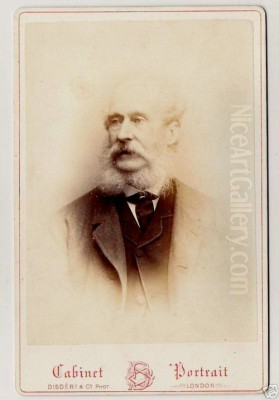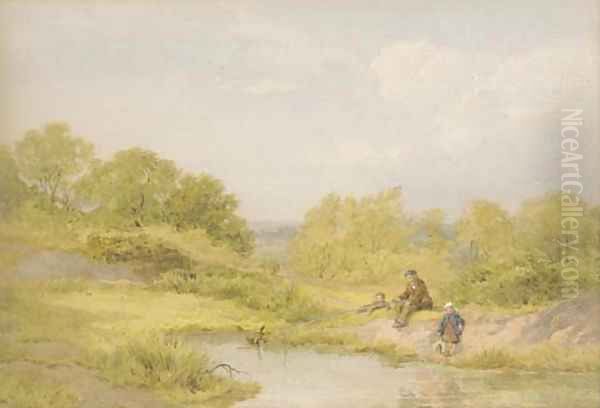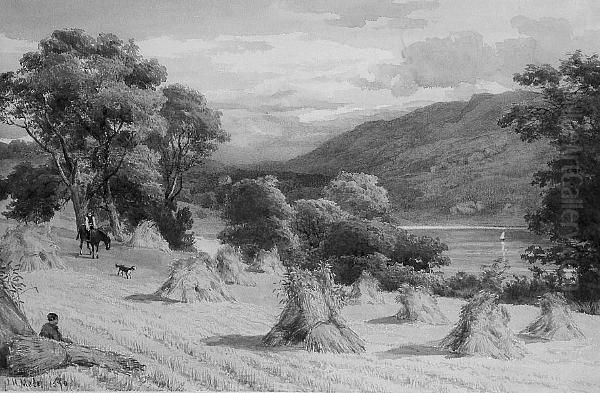
John Henry Mole stands as a significant figure in the landscape of nineteenth-century British art, particularly celebrated for his contributions to the medium of watercolour. Active during a period often referred to as the golden age of English watercolour painting, Mole carved out a distinct niche for himself through his sensitive depictions of landscapes, coastal scenes, and gentle genre subjects. Born in 1814 and passing away in 1886, his career spanned a dynamic era of artistic change and development. Initially trained in law and starting his artistic life as a miniature painter, he successfully transitioned to become a highly respected landscape artist and a prominent member of the Royal Institute of Painters in Water Colours. His work, characterized by its delicacy, atmospheric quality, and often sentimental charm, captured the essence of the Victorian sensibility towards nature and domestic life.
Early Life and Artistic Beginnings
John Henry Mole was born in Althorp, Northamptonshire, in 1814. His early life, however, took him away from the rural setting of his birth to the bustling industrial city of Newcastle-upon-Tyne in the north of England. It was here that he initially pursued a career far removed from the arts, working as a solicitor's clerk. This legal background provided a perhaps unexpected start for a man who would dedicate his professional life to visual representation. The discipline and attention to detail required in legal work may, however, have subtly informed the meticulousness evident in his later artistic practice.
Despite his initial career path, the pull towards art proved strong. By 1835, Mole made the decisive step to become a professional artist. His first chosen specialization was miniature portrait painting. This was a demanding field requiring exceptional precision and a delicate touch, skills honed perhaps during his time away from the easel. Miniatures were still a popular form of portraiture in the early Victorian era, valued for their intimacy and portability, though the rise of photography would soon challenge their dominance. Mole's entry into this field marked the true beginning of his journey as an artist, laying the groundwork for his future explorations in watercolour.
The Miniature Painter

During the late 1830s and early 1840s, John Henry Mole established himself as a competent miniature painter. Working primarily in Newcastle, he likely catered to the local gentry and burgeoning middle class seeking personal mementos. Miniature painting on ivory or vellum demanded painstaking detail, fine brushwork, and the ability to capture a likeness within a very small format. This early practice undoubtedly refined Mole's control over his medium and his eye for detail, qualities that would later translate into his landscape watercolours.
His growing reputation is evidenced by his acceptance at the prestigious Royal Academy of Arts in London. In 1845 and 1846, he exhibited miniature portraits at the RA's annual exhibitions. This was a significant achievement, indicating recognition beyond his regional base and placing him within the orbit of the national art scene. Exhibiting at the Royal Academy was a crucial step for any ambitious artist seeking wider patronage and critical notice. While artists like Sir William Charles Ross dominated the field of royal miniatures, Mole's participation showed his competence in this intricate art form before he shifted his primary focus.
Transition to Landscape and Watercolour
While achieving success as a miniaturist, John Henry Mole's artistic interests began to shift towards landscape painting, particularly in the medium of watercolour. This transition occurred during the 1840s, a period when watercolour painting was experiencing unprecedented popularity and critical acclaim in Britain. Artists like J.M.W. Turner and David Cox had already demonstrated the medium's expressive potential, elevating it far beyond its earlier status as merely a tool for topographical record or preparatory sketches.
Mole embraced watercolour with enthusiasm, finding it suited to capturing the nuances of light, atmosphere, and the specific character of the British landscape. His training in miniatures likely provided him with a foundation in precise drawing and delicate washes, which he adapted to the broader vistas of nature. He began to explore the countryside around him, drawing inspiration from the landscapes of Northern England, particularly Northumberland, where he had spent his early professional years. This move away from portraiture towards landscape marked a pivotal moment in his career, aligning him with the dominant trends and tastes of the Victorian art market.
Mastery of Watercolour Technique

John Henry Mole developed a distinctive and highly skilled watercolour technique. His style is often characterized by its delicacy and refinement, particularly in his rendering of atmospheric effects. He possessed a keen ability to capture the subtle interplay of light and air, lending his landscapes a sense of immediacy and naturalism. While capable of meticulous detail, reminiscent of his miniature painting background, his style could also encompass broader, more fluid washes, especially in depicting skies and water.
He often worked with transparent washes, building up layers of colour to achieve depth and luminosity. However, like many Victorian watercolourists, he was not averse to using bodycolour (gouache, or watercolour mixed with white pigment) to add highlights, texture, and opacity where needed. This combination of techniques allowed for both subtlety and strength in his compositions. His handling of foliage, rocks, and water demonstrates a careful observation of nature, translated through a controlled yet sensitive brush. His palette often favoured gentle, harmonious colours, contributing to the tranquil and sometimes idyllic mood of his works.
Favourite Subjects: Landscapes and Coastal Scenes
Throughout his mature career, John Henry Mole focused predominantly on landscape and coastal subjects. His inspiration was drawn from various regions of the British Isles, reflecting his travels and favoured sketching grounds. The rugged beauty of Northumberland, with its dramatic coastline and historical associations, remained a recurring theme. He was also drawn to the picturesque scenery of the Lake District, North Wales, and the Scottish Highlands, areas beloved by many landscape painters of the era, following in the footsteps of earlier masters.
Mole showed a particular affinity for coastal and beach scenes. He excelled at capturing the expansive vistas of sand and sea, the changing effects of light on water, and the activities associated with coastal life. These scenes often possess a bright, airy quality, conveying the freshness of the sea breeze and the warmth of sunlight. Works like Hastings Beach (1859) exemplify his skill in this genre, depicting figures enjoying the seaside with a backdrop of cliffs and sparkling water. His landscapes, whether inland or coastal, consistently reveal a deep appreciation for the natural beauty of Britain, rendered with sensitivity and charm.
Genre Painting and Figures
Alongside his pure landscapes, John Henry Mole frequently incorporated figures into his compositions, often creating gentle genre scenes. These works typically depict aspects of rural or coastal life, with a particular focus on children and families. His figures are often shown engaged in simple activities – playing on the beach, gathering shellfish, resting by a cottage door, or walking along country lanes. These scenes tapped into the Victorian fondness for subjects related to childhood innocence, domesticity, and the perceived virtues of rural life.
While primarily a landscape painter, the inclusion of figures added narrative interest and emotional resonance to his work. These elements often carry a degree of sentimentality, a common characteristic of much popular Victorian art. Artists like Myles Birket Foster and Helen Allingham also specialized in similar idyllic rural scenes, reflecting a widespread taste. Although some critics occasionally noted that Mole's figure drawing was perhaps less assured than his handling of landscape elements, the figures generally integrate harmoniously into his overall compositions, contributing significantly to their appeal and narrative content. His work Nearly Home (1842) is an early example suggesting this interest in narrative and human elements within the landscape.
The New Society of Painters in Water-Colours / Royal Institute
John Henry Mole's professional standing was significantly enhanced by his long and active involvement with the New Society of Painters in Water-Colours (NWS). Founded in 1831 as an alternative to the more established Society of Painters in Water-Colours (the "Old" Society or OWS), the NWS provided a vital exhibition venue for a growing number of watercolour artists. Mole began exhibiting with the NWS and was elected an Associate member in 1847, followed swiftly by his election to full Membership in 1848.
His commitment to the Society was unwavering. He exhibited regularly at its annual shows for nearly four decades, contributing significantly to its reputation and success. His dedication and the high regard in which he was held by his peers culminated in his election as Vice-President of the Society in 1884. By this time, the NWS had received royal recognition and had been renamed the Royal Institute of Painters in Water Colours (RI). Serving as Vice-President alongside the President, Sir James Linton, underscored Mole's senior status within the British watercolour establishment. His involvement highlights the importance of such societies in providing artists with exhibition opportunities, professional networks, and collective identity during the Victorian era. Other prominent members during different periods included artists like Louis Haghe, Thomas Collier, and E. M. Wimperis.
Exhibitions and Recognition
Beyond his core commitment to the NWS/RI, John Henry Mole sought exhibition opportunities at various other prestigious venues, ensuring his work reached a wide audience. As mentioned, his early career saw him exhibiting miniatures at the Royal Academy of Arts in London in 1845 and 1846. Although his primary medium became watercolour, he did occasionally work in oils and submitted an oil painting titled Carrying Peat to the Royal Academy in 1879. This demonstrates his versatility and continued ambition to engage with the premier art institution in Britain.
Mole also exhibited his works, primarily watercolours, intermittently at other London galleries, including the Society of British Artists (located in Suffolk Street) and the Grosvenor Gallery. The latter, opened in 1877, was known for showcasing more avant-garde or aesthetically inclined art, suggesting Mole's work appealed across different segments of the exhibition landscape. Furthermore, his participation extended beyond the capital; he is known to have exhibited at the Bristol Institution, indicating a reach into regional art circles. This consistent presence in major exhibitions solidified his reputation and contributed to the commercial success of his art during his lifetime. His election as Vice-President of the RI in 1884 was the capstone of this public recognition.
Mole and His Contemporaries
John Henry Mole practiced his art during a vibrant and crowded period in British art history. He was a contemporary of the later years of J.M.W. Turner and the mature period of influential figures associated with the Pre-Raphaelite Brotherhood, such as John Everett Millais, Dante Gabriel Rossetti, and William Holman Hunt, although Mole's style remained largely independent of their detailed symbolism and medievalism. His landscape work sits more comfortably within the tradition of detailed naturalism and picturesque sensibility seen in the work of many fellow watercolourists.
Within the watercolour societies, he rubbed shoulders with numerous talented artists. The Old Watercolour Society boasted members like David Cox, Peter De Wint, and Samuel Prout in its earlier days, and later figures whose work sometimes paralleled Mole's interest in landscape and genre. Within his own society, the NWS/RI, he was part of a large and diverse group. His detailed, often sunny depictions of rural and coastal life find echoes in the immensely popular work of Myles Birket Foster, though Mole often maintained a slightly broader touch. He shared an interest in coastal scenes with artists like E. M. Wimperis. Unlike the powerful, sometimes critical, voice of John Ruskin, who championed Turner and the Pre-Raphaelites, Mole's art aimed for a gentler, more accessible appreciation of nature and everyday life. His long tenure and eventual Vice-Presidency at the RI place him as a respected establishment figure among contemporaries like Sir James Linton and Thomas Collier. His work represents a significant, popular strand within the complex tapestry of Victorian art.
Representative Works
Several works stand out as representative of John Henry Mole's artistic output and success. Nearly Home, dated 1842 and exhibited at the New Society of Painters in Water-Colours that same year, is noted as an early example of his quality work, likely blending landscape with a narrative or genre element as suggested by the title. This piece would have helped establish his reputation within the society he was soon to join formally.
Hastings Beach, painted in 1859, is a prime example of his popular coastal scenes. Now housed in the Wichita Art Museum, this watercolour likely depicts holidaymakers or local families enjoying the seaside, a common theme in Victorian art reflecting the rise of coastal resorts. It showcases his ability to render sunlight on sand and water, create a lively atmosphere, and integrate figures naturally into the landscape setting. Such works were highly sought after by middle-class collectors.
His occasional foray into oil painting is represented by Carrying Peat, exhibited at the Royal Academy in 1879. The subject suggests a scene from rural life, possibly set in Scotland or another area where peat was harvested for fuel. Exhibiting an oil painting at the RA indicates Mole's continued desire to engage with the perceived higher status of oil painting, even though his primary reputation rested on his watercolours. These examples illustrate the range of his subjects – from genre-inflected landscapes to pure coastal views – and his activity across different media and exhibition venues.
Later Life and Legacy
John Henry Mole continued to paint and exhibit actively throughout his later years. His dedication to the Royal Institute of Painters in Water Colours remained strong, culminating in his Vice-Presidency in 1884, just two years before his death. This position affirmed his status as a senior and highly respected figure within the London art world, particularly in the field of watercolour painting. He maintained his focus on the landscape, coastal, and genre subjects that had brought him success, refining his style rather than making radical changes.
His later work continued to be appreciated for its technical skill, charm, and sensitive observation of nature. He resided in London during his final years, placing him at the centre of the British art scene. John Henry Mole passed away in London on December 13, 1886. He was buried in Brompton Cemetery, a prominent Victorian burial ground that is the final resting place of many notable figures from the arts and sciences.
Mole's legacy lies in his contribution to the rich tradition of British watercolour painting during the Victorian era. While perhaps not an innovator on the scale of Turner or Constable, he was a highly accomplished practitioner who captured the spirit of his time. His works remain appealing for their technical finesse, atmospheric qualities, and gentle depictions of the British landscape and its inhabitants. He represents a significant aspect of Victorian taste, favouring accessible beauty, sentiment, and skilled craftsmanship. His paintings are held in various public collections, including the Victoria and Albert Museum in London and regional galleries, ensuring his contribution is not forgotten.
Conclusion
John Henry Mole navigated the Victorian art world with considerable success, transitioning from a legal clerk to a miniature painter, and finally establishing himself as a leading watercolour landscape and genre artist. His long association with the New Society of Painters in Water-Colours, later the Royal Institute, culminating in its Vice-Presidency, attests to the high esteem in which he was held by his peers. His work, characterized by delicate execution, atmospheric sensitivity, and a focus on the picturesque beauty of the British Isles and the charms of rural and coastal life, resonated deeply with Victorian audiences. While reflecting the prevailing tastes and sentiments of his era, Mole's paintings endure through their technical accomplishment and quiet beauty, offering a valuable window into the landscape and sensibilities of nineteenth-century Britain. He remains an important figure for understanding the breadth and depth of the British watercolour tradition.